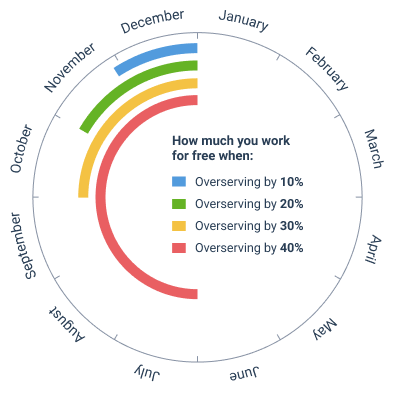
A while ago, you started a business and were struggling to make your way in the market. To retain one of your first clients, you offered them an additional discount and free support of your product. Back then, they were happy and you were happy too, but now, things don’t look so bright.
Today, the client won’t extend the agreement unless you give them another discount, and become livid when your manager tries to mention service fee raise. That’s definitely not what you aimed at! Meet overservicing – the monster familiar to almost any small business owner.
Why Overservicing is Bad
Being attentive to customers is a must and caring about their success is what you are expected to do. But often, companies are taking things too far: additional services at no cost, response times much shorter than agreed, discounts for no valid reason, and many other perks at the company’s cost.
Does It Work?
Of course, companies do it in the expectation of building perfect relationships with their clients. But what they actually achieve is far from an idyllic picture. In reality, overservicing negatively affects both financial wellbeing of the company and its relationships with the clients. Let’s see how it happens.
-
Revenue losses
Overservicing takes many forms, and decreasing company’s revenue is what they have in common. Not updating service fees, offering free services that the competitors are billing for, providing more discounts than your finances allow – all this directly undermines profitability of your work. And if your practices make your employees work overtime, this also adds to the pile of unnecessary expenses, while creating a pressuring work environment.
-
Unrealistic expectations
At first, your clients may be impressed by your generosity and happy to have chosen you instead of your competitors, but their excitement fades as the time passes. Very soon, they’ll be expecting you to do your work faster than agreed, easily get annoyed when you deny their bells-and-whistles requests, and threaten you with leaving for your strongest competitor if you don’t give them an extra discount. Their expectations make it even more difficult to revise the terms of services, closing the overservicing loop.
-
Difficult planning
How much time and effort does change management take if you never say no to the customer? Forever, at least. This is how you get scope creep: requests of various importance pile up depleting company’s resources and postponing delivery dates. And if your client’s expectations are too high, hearing about additional time and payments makes them quite unhappy. Brace yourself: complaints are coming.
How Exactly Bad is It?
At first, it may seem harmless: just a small additional service that won’t take too much effort anyway. However, in the long term, the effects of overservicing can range from mildly decreasing your revenue to turning your business into a sinking ship. Recalculated into time of free work, it looks like a really dangerous practice.

- If you’re overservicing your clients by 10%, it’s like you’re working for them for free from Thanksgiving to the year end.
- Overservicing by 20% equals to working for free from Halloween to the year end.
- Instead of a 30% overservicing, you could just work for free the entire fourth quarter.
- And the result of a 40% overservicing is no better than half a year of free work.
If you’ve noticed any signs of unaffordable free work, it’s time to figure out about why it happens, and take action. Let’s start by learning more about how and why overservicing occurs.
Why It Happens
Overservicing is an inertial process that is hard to stop. Companies stick to it, even suffering from its harmful effects. The first step to eliminating it is identifying your specific root cause. Here are the most common reasons why companies keep overservicing their clients:
-
You’re trying to be competitive
Offering more than your competitors at the same price actually is your strong point – until it starts to threaten your resources. Free work is not the only way overservicing harms your success: spending time on activities that don’t bring you any benefits blocks you from actually profitable work. This can increase your lost opportunity costs to the extent where it undermines profitability of your entire business.
-
You’re allowing poor project planning.
It’s easier to insist on additional free services if there’s no clearly defined scope of work. If your project is planned too vaguely, you’re inviting scope bloat and putting your team at the risk of free work.
-
You’re being a people pleaser
Making clients happy is most likely the standard in your field and you’re expected to do that. But remembering of your own wellbeing is key here: being nice to anyone at your own cost usually ends worse than you expect – and overservicing is a perfect example.
-
You’re overly committed to the “customer is king” approach
Yes, you’re here to do the work your customer needs, but it doesn’t mean that you need to take action upon any requests and meet all expectations, including not so reasonable ones.
Sounds like a bunch of costly errors, but there’s hardly any business that managed to avoid them at the very beginning. If you’ve noticed that any of the reasons listed above apply to you, see it as an opportunity to learn an important lesson, and take action to prevent overservicing in the future.
How to Avoid Overservicing
If you’ve identified the reasons why you tend to provide service at your own cost, take measures to mitigate the consequences and prevent it in the future. There are several aspects of prevention strategy that need to be incorporated in your working process.
-
Plan your projects clearly
This step is key for preventing project scope from bloating and clients from putting unreasonable demands. Define what works you do for the client, and – more importantly – what works you don’t do within the project scope. Estimate work time in advance, and set deadlines. Implement a project management software with time tracking functionality like actiTIME to plan your projects accurately and see where your time goes.
-
Clarify the effects to your employees
Managers and regular employees don’t always realize how harmful overservicing is. Explain how it affects company’s revenue and employees’ work time, and suggest a strategy that would help them push back if a client sets new requirements or demands.
-
Build communication flow that doesn’t allow misunderstanding
Clearly communicate to the clients what the realistic project scope is, what services are included in the payments, and what is a possible leeway if any changes appear in the course of project work. If it becomes clear that no reasonable communication is possible, probably it’s time to retire your client – consider it the last resort, but not totally an unacceptable one.
Summary
“Just a small service that we’ll offer as a courtesy to retain that client. It’s nothing!” – you could think first, only to discover later that such practices slowly ruin your business. Taking into account that overservicing is typical for new and small businesses, its consequences can be devastating. Be aware of its harmful effects, and build processes that prevent your projects’ scope from bloating, protect your team from unnecessary overtime hours, and ensure productive and profitable work.















































